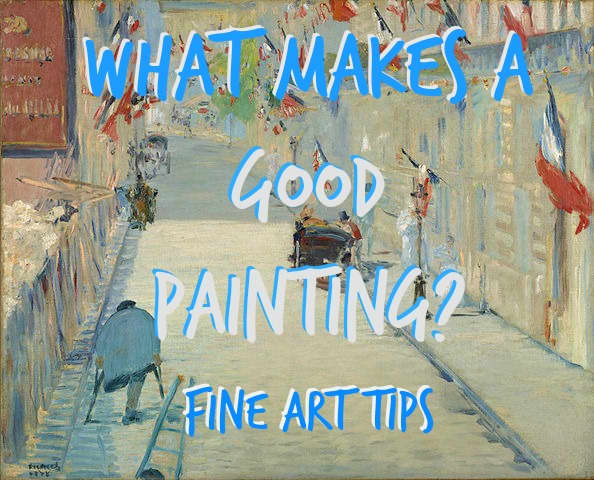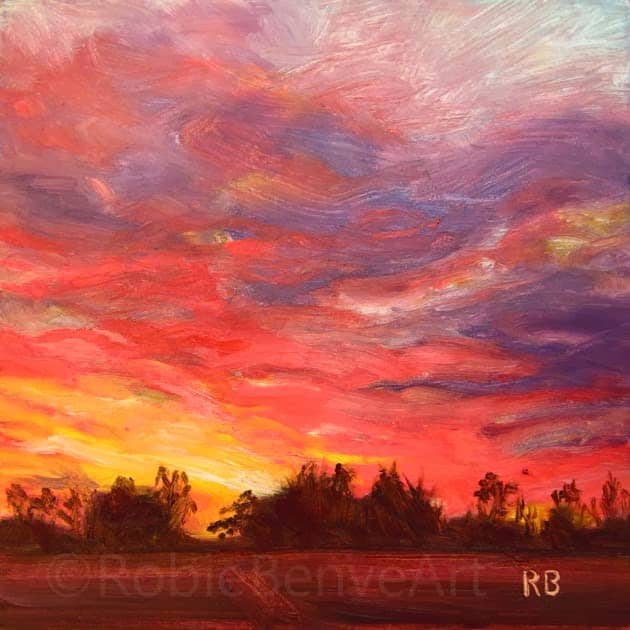What Is A Good Painting
Robie is an artist who loves sharing what she has learned about art and painting in the hope that it might help other creatives.

All the great artworks, no matter the style or the medium, have some essential elements in common. - The content of this article is copyrighted by Robie Benve - Image: Eduard Manet, The Rue Mosnier with Flags, 1878,
Eduard manet, via Wikimedia Commons
Characteristics That Great Artworks Have in Common
In the end, what makes a painting successful is that its composition, color, and subject matter all work harmoniously to deliver a unified and well-executed artwork.
There are a few main elements that typically come together to make a painting successful.
What Do Masterpieces Have in Common?
Though there isn't one single right answer to that question, there are definitely some common elements in every successful painting.
Many paintings now considered masterpieces, were not well received when they were first created (think of all the Impressionists or the modern artists) but changes in society, culture, and tastes gave them the aura they have today.
So, the rule number one should be "be true to your guts and be original." Don't worry too much about what others think.
That said, let's take a look at all the elements that most good paintings have in common.
Three Groups of Characteristics of Great Paintings
Accomplished and successful artists pay attention to the following three aspects of each artwork. Each item on the list is composed by sub-categories, and this article will go into each one and explain what it means.
A. Technique and technical aspects
B. Personal and emotional involvement
C. Novelty
Keep reading to learn about each group of characteristics more in detail.
What Makes a Good Painting?
| Technical Aspects | Personal & Emotional Involvement | Novelty |
|---|---|---|
| Composition | Freshness | Innovation |
| Choice of Colors | Inspiration | Originality |
| Focal Point | Readiness | Ingenuity |
| Patterns & Groups |
A. Technical Aspects
The outcome of a painting will depend on many things, but most of all it is determined by your choice of colors and how you choose to apply, arrange, and group shapes in the picture.
Technical Aspects of a Successful Painting
A1. Composition
A2. Choice of Colors
A3. Focal Point
A4. Patterns and Groups
Let's see how composition, choice of colors, focal point, and how you choose to arrange shapes are crucial for the success of a painting.
A1. Composition
An armature, or composition structure, is a structure that will determine the placement of the main masses in the painting and help guide the eye's movement through them.
There are many rules and tips on composition schemes. You can study them all and work hard to apply them. Or you can use just your guts and compose the way that looks good to you, disregarding the classic designs.
I recommend that at the beginning you simplify the decision-making process of painting by skipping the formal composition rules and just follow your instinct. Compose your image the same way that you would take or crop a picture with your camera, letting your instinct decide what looks best.
Look at the scene you want to paint and crop it with L-shaped cardboard strips in front of your eyes. Position them to form a rectangle proportional to the size of your canvas. They will help you see what looks best and choose how to crop your subject.

Examples of compositional structures inspired by Edgar Alwin Payne's book "Composition of Outdoor Paintings".
Robie Benve, CC-BY-NC
A2. Color
Planning your color combinations in advance not only makes painting faster, because several decisions have already been made but also can help you stay focused on the initial idea and inspiration, creating a well-thought color scheme.
Color can be used to convey atmosphere and mood.
There are different kinds of color scheme to choose from. Here is how you can use the color wheel to help you choose your color combinations.
A3. Focal Point
The focal point of a painting is the area of major interest, where the eye of the viewer is naturally led.
What is the painting about? What are you trying to say? That should be your focal point.
Avoid placing the focal point in the center of the canvas, both horizontally and vertically, or too close to the edges.
The ideal positions for a focal point are on the lines of thirds – obtained dividing the canvas into thirds horizontally and vertically. Most often artists place the focal point on a sweet spot, identified by the points where the lines of thirds intersect.
The focal point is usually the area with
- Highest contrast of value
- Sharpest edges
In addition to the focal point, it is good practice to have a couple of more secondary elements of interest, placed to form a triangle with the main character and two supporting players.

"Joaquín Sorolla y Bastida - Rocas de Jávea y el bote blanco" by Joaquín Sorolla - Museo Carmen Thyssen, Málaga.
Licensed under Public Domain via Wikimedia Commons
A4. Patterns and Groups
Our brain automatically looks for patterns in a picture.
Create value patterns by grouping darks and lights into bigger shapes. It makes the painting more pleasant for the viewer. To do this, simplify differences in colors and values. For example, if painting a tree don't paint every single leaf, but a shape of the tree canopy with a unified value. You can variate the colors within the shape but you should keep the value within the mass uniform.
Also, our brain, even if we are not aware of it, tends to pair up elements. A picture with two very similar objects, like two trees or two fruits of the same size and shape, becomes static, almost boring. Odd numbers are always more interesting. Keep the number of similar elements odd, and you'll keep the viewer's eyes moving and your viewer more captivated.
B. Personal and Emotional Involvement
It is very important that you enjoy the process. If you paint with enjoyment and inspiration it will show through in the finished painting.
Personal and Emotional Involvement in a Successful Painting
B1. Freshness
B2. Inspiration
B3. Readiness
Let's see how the personal components of freshness, inspiration, and readiness are crucial for the success of a painting.
B1. Freshness
When you first start a painting, you have a lot of enthusiasm for the scene. You are inspired by what you want to paint and you put a lot of energy into it.
Chances are that when you are into the painting things don't look as you expected, you see some mistakes that you are not sure how to fix, and you lose your optimism.
Strive to keep the freshness and enthusiasm up. If you get tired, take a break.
Tiredness causes lazy and unnecessary brushstrokes that more than advancing, harm the painting.
Remind yourself continuously what captivated you about that particular scene, what was so exciting that enticed you to paint it. Keep your focus on what you are trying to express.
B2. Tips on How to Stay Fresh and Inspired:
Sometimes we reach a point where we feel stuck and it's hard to envision how the painting can proceed and improve.
There is always a phase in the painting process during which the painting looks messy and hopeless, I call that the ugly stage. Don't let your self-criticism stop you, fight through the tough times.
Here are a few tips to overcome those hard moments that affect every creative.
- Take regular breaks.
- Work on several paintings at the same time, switching from one to another when you are in a rut.
- Work on varied subject matters.
- Change point of view: look at the painting in a mirror or upside down. A fresh perspective will let you see better what needs improvement.
B3. Readiness
I find that one of the worst enemies of artistic productivity is wasting time. It's important to start painting with things ready to go.
Your space should be set up to keep distractions to a minimum, with what you are going to need (paint, brushes, rags, water, etc) all easily reachable. For this, it's important to keep your space decluttered and organized, keeping all your tools handy, including your reference material.
But before you can start, make sure you have a plan. Start when you are ready and be ready to start when you show up.
Analyze the image/scene before you begin
- Light source
- Shadows
- Dominant color
- Focal point or main focus
Preliminary observation allows starting with a plan. What are you going to express?
What characteristics inspired you and you want to make sure you express?
With a clear plan, it's easier to stay focused and to react when things go wrong.

November Sunset, a small oil painting on gesso board
Robie Benve Art, BY-NC
C. Novelty
Uniqueness and originality are important in a work of art.
Creating Something Never Seen Before
Novelty is synonymous with other terms such as
- Innovation
- Originality
- Ingenuity
Uniqueness in art can come from an original approach or idea that departs from traditional or previously established forms.
It sprouts from a new idea or approach. It can be found on the subject-matter, style, size, materials, presentation, and many other elements of art.
Any new artwork requires some degree of novelty to be successful.
Heads Up:
Unfortunately, the public sometimes has a hard time accepting or understanding original works that break with established and accepted traditional forms.
In general, human beings do not like change, and this applies to the art world as well.
So when something that departs from tradition is presented, at first it might not get the appreciation that it may gain later, once people have had time to adjust and absorb what is really being placed before them.
Don't let lack of public appreciation stop you.
Follow your inspiration.
Be daring.
Enjoy the Painting Process and Learn from Your Mistakes
Painting is a continuous learning experience.
Every painting presents different challenges and many times those challenges can become amazing opportunities for experimenting and self-improving. That is a nice way to say that with each work comes the opportunity for failure.
The Struggle Pays Off, Eventually
It may not be in the current painting that you see the results, but the next ones will definitely benefit from the struggle and the problem solving that you went through today.
Keep painting.
Enjoy every step of it.
Learn from your mistakes.
Paint some more.
Have fun! : )
Don't think about making art, just get it done. Let everyone else decide if it's good or bad, whether they love it or hate it. While they are deciding, make even more art.
— Andy Warhol
This content is accurate and true to the best of the author's knowledge and is not meant to substitute for formal and individualized advice from a qualified professional.
Questions & Answers
Question: I like to do watercolor portrait paintings, mostly from a photo and the majority of the subjects are artists, a few politicians, and family members. Can you, the writer of this article, suggest any fresh ideas for me to paint, to improve and better myself and be happier at the end of the painting process?
Answer: For portraits, you have an extra layer of difficulty compared to any other subject: the likeness to the real person. To make sure you get that right, keep measuring and never get tired of comparing.
Compare sizes, angles, colors, and especially tone and intensity. Having the correct darks and lights, and correctly positioning bright and dull colors, create the portrait.
Start by establishing the main shapes, make sure the proportions and the forms are correct, then move to the details.
Eyes, mouth, and nose are specific to each person. Make them resemblant and lively.
© 2016 Robie Benve
Robie Benve (author) from Ohio on August 21, 2020:
Hi Nelvia, yes, crazy how some things sound easy until you try to do them, lol. But at least let's hope that knowing the theory of what should work will help us during the decision making process of painting. Thanks for your comment.
Nelvia from Atlanta on August 12, 2020:
Excellent advice, it seems to easy to achieve, but we know it is not. Good design and balance can cover a lot of weaker issues. To really use and paint our voice we have to trust our gut as you say.
Danny Nichols on February 12, 2020:
Excellent advice, well balanced and thought out
Kathie Morris on December 13, 2019:
Thankyou so much. I have learnt so much
Robie Benve (author) from Ohio on February 01, 2016:
Thanks Glimmer Twin Fun, I did not plan it to be a thought-provoking article, but if that's the case I am very happy. I try to write hubs about concepts that I learn in my art journey, in the hope that it may help someone discover them a little faster than I did. Knowing some of the basics, like what makes a good painting, is surely nothing to take for granted. I learn every day from things I read. :) Glad you found the read interesting.
Claudia Mitchell on January 22, 2016:
This was interesting to me. I came into thinking that a good painting is one that someone likes, but never thought about what else goes into it. And thinking about my favorite pieces that I've seen over the years, they all have many of these characteristics. Thank you for this thought-provoking article.
Robie Benve (author) from Ohio on January 19, 2016:
Well said Denise, it's hard to know what kind of art the public wants and likes, and trying to paint chasing the thread of what sells can be very stressful and frustrating.
I rather paint what ignites my inspiration, and if other people like it too, that makes me happier, but I find that when I paint only for myself, enjoying the process, I get better results than when I paint for an audience. For example, knowing that I need to paint for a show, I have in the back of my mind that the piece will be in an exhibit, and that influences the way I paint.
Even knowing that I will post a photo of the painting on my social networks does something to my brain.
Best of all is painting for the joy of painting, having the luxury of saying to yourself: "no one needs to see this, I'll show it only if I like it, and definitely only if I want to".That frees your mind from worries about the outcome and really opens up opportunities to experiment and learn with each painting.
Thanks a lot for your Thoughtful comment, Paintdrips.
Denise McGill from Fresno CA on January 16, 2016:
Great information. I always love it when someone tackles the age-old question. I think there is an element of chance to any painting too. Something about being in the right place at the right time with the right composition to strike a cord with the populace. Think about Grandma Moses. Totally uneducated in art, she would have remained an obscure primitive artist painting for her own amusement if it had not been the end of a World War and the people suddenly wanted to see "back to a simpler way of life" type of pieces. Sometimes there is no knowing what the public wants and you should paint what you like no matter what. Then if people like it too, so much the better. Good luck.
Blessings,
Denise
What Is A Good Painting
Source: https://feltmagnet.com/painting/What-Makes-A-Good-Painting
Posted by: etheridgethersen.blogspot.com

0 Response to "What Is A Good Painting"
Post a Comment